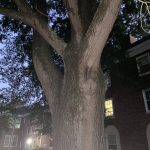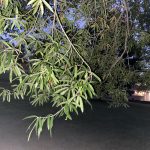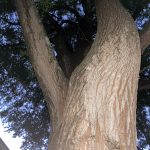
the tree I have been sitting under
I decided to identify the tree I sit under in my sit-spot. I always look at it when I go to my spot and it is a beautiful tree even though it has a dark color to it which gives off this spooky vibe. It is a major part of my sit spot and I have been curious to learn more about the tree that I sit under.
The tree has a dark black-brown tint to it along with a grey color on its bark. There are patches of green moss that live on the tree. It is not a soft fluffy moss but almost like a chalky hard-to-the-touch moss. The mysterious tree has one dead branch that reaches out into the open area. Like the others, the branches of the tree are very long, they are not thick, but they are not super skinny. The leaves of the organism have green, thin, long leaves and some of the leaves have turned yellow due to the cool air and the changes in the seasons.

The leaves of the willow oak
The organism that I identified was by the leaves and the bark of the tree. It was challenging to identify the tree at first, it was not that exciting. At first when I looked at the tree, I thought to myself that it could be an ash tree. I have heard that they were one of the main trees here on the Hollins campus, but as I was looking through the pictures I took and the pictures on the internet, the leaves did not match up. I continued my search and I had the idea to go onto a Hollins page about the trees on campus. It gave a descriptive caption about where the different types of species are, and I read the description about where they were located. I finally concluded that the species of the tree is a Quercus Phellos, also known as a willow oak.

a close up of the bark of the willow oak
In 1723, the first scientific observation was made. The wood was used since the pioneering days, they used the wood of the willow oak for bar tops, wagon axles, stairs, and railings. They are native to poorly drained areas, they are about 60 feet tall and they have drooping lower branches. They are normally used for timber and they belong to the red oak group of the genus Quercus. It also is in the beech family, which makes the willow oak have willowlike leaves.

Does it look similar to a willow tree with the long flowing branches? If so it makes a lot of sense why it would be called a willow oak since it is in the oak family but looks like a willow. I sit under a willow tree for my sit spot so I am curious of the differences in appearance between the trees.